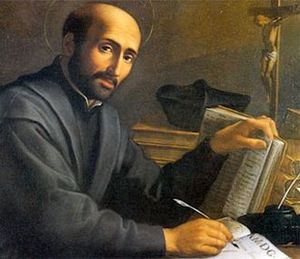 “Ad Majorem Dei Gloriam” (“For the greater glory of God”) — the motto of St. Ignatius.
“Ad Majorem Dei Gloriam” (“For the greater glory of God”) — the motto of St. Ignatius.
On 31 July is the Feast of Saint Ignatius of Loyola. He was probably born in 1491, in the Castle of Loyola in Azpeitia, in the village of Guipuzcoa, near the Pyrenees. His father, Don Beltran, was a knight of Oñaz and Loyola, head of one of the oldest & most noble families of the region. His mother’s lineage was also eminent, Doña Marina Saenz de Licona and Balda. Iñigo (name received at his baptism) was the youngest of eight sons and three daughters of the couple. Iñigo fought against the French in north of Castilla. His brief military career ended abruptly on May 20th, 1521, when a bullet from a canon hit his leg during the battle in defense of the Castle of Pamplona.
After Iñigo’s injury the Spanish troops surrendered. The French did not abuse their victory and sent the injured Spaniard on a stretcher to the Castle of Loyola, his native place. The broken bones in his legs did not heal well, and the doctors considered the need to break them again and operate. Iñigo was in favor of the operation and tolerated it heroically, for he was anxious to return to his worldly affairs. Consequently, he had a severe fever due to complications, so much so that the doctors thought Iñigo would die before the feast day of Saints Peter and Paul. Nonetheless, his condition improved even though his recuperation lasted for several months.
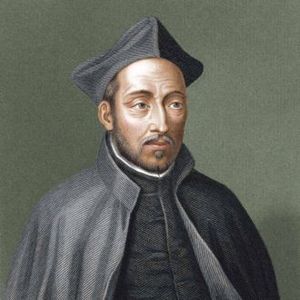 The operation on his broken leg and knee resulted in a deformity. Iñigo insisted that the surgeons cut the protrusion, even though he was counseled against it, because of the painful process. He did not want to be held down and resisted this butchering without complaint. To avoid his right leg becoming shorter, Iñigo remained several days with his leg stretched out by heavy weights. Due to these methods, he was lame for the rest of his life.
The operation on his broken leg and knee resulted in a deformity. Iñigo insisted that the surgeons cut the protrusion, even though he was counseled against it, because of the painful process. He did not want to be held down and resisted this butchering without complaint. To avoid his right leg becoming shorter, Iñigo remained several days with his leg stretched out by heavy weights. Due to these methods, he was lame for the rest of his life.
Trying to distract himself during the time of his recovery, Iñigo requested some books of chivalry (adventures of war and horses, which he always enjoyed). But the only books found in the Castle of Loyola was a book on the history of Christ and a volume on the life of the saints. Iñigo started to read them, and little by little he started to have more interest in them, spending entire days reading. He used to say, “If those men were made of the same flesh as I, I also can do what they did.” Inflamed by fervor, he proposed to go on a pilgrimage to the Sanctuary of Our Lady and enter as a lay brother to a monastery. But such ideas were not constant, and his anxiety of personal glory and his love for a lady occupied most of his thoughts. When he returned to the books on the lives of the saints, he understood his vanity and the world’s glory and sensed that only God was able to satisfy his heart.
These fluctuations allowed Iñigo to observe a difference in himself: the thoughts that came from God left him full of consolation, peace and tranquility; the worldly thoughts had some delight, but only left him with desolation and emptiness. Finally Iñigo decided to imitate the saints and began to do as many kinds of corporal penances as possible and to cry for his sins.
The visit to the Blessed Virgin: purification in Manresa
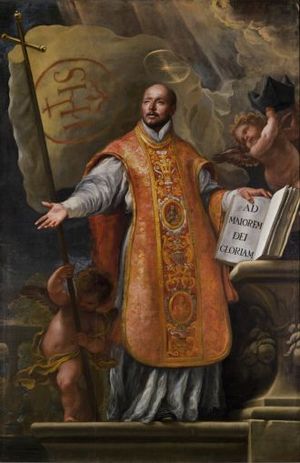 One evening the Mother of God appeared, surrounded with light and in her arms the Child Jesus. This vision deeply consoled Ignatius. After his recuperation, he made a pilgrimage to the Our Lady of Montessarat Sanctuary, where he decided to live a life of penance. His goal was to reach Holy Land, and for this journey he had to depart from Barcelona which was close to Montserrat. However, the city of Barcelona was closed due to contagious diseases in the region.
One evening the Mother of God appeared, surrounded with light and in her arms the Child Jesus. This vision deeply consoled Ignatius. After his recuperation, he made a pilgrimage to the Our Lady of Montessarat Sanctuary, where he decided to live a life of penance. His goal was to reach Holy Land, and for this journey he had to depart from Barcelona which was close to Montserrat. However, the city of Barcelona was closed due to contagious diseases in the region.
Therefore he had to wait in a small town called Manresa, not fall from Barcelona and Montserrat. God had other urgent plans for Ignatius at that moment in his life. He wanted to take Ignatius to a deeper union with him in prayer and total poverty. He lounged there, sometimes with the Dominicans in the convent and other times in a shelter for the poor. In order to pray and do more penance he would go to a near-by cave. He lived this way for almost a year.
“For the purpose of imitating Christ Our Lord and to be more like Him in truth, I choose poverty with Christ; poverty instead of riches; more than honors, humiliations with Christ humiliated. I want to be known for being idiotic and crazy for Christ – He was the first to go through it before being known as wise and prudent in this world.” He decided to “choose the way of God, instead of the way of the world.”
After the consolation of the beginning, a period of spiritual aridity came to Ignatius; prayer and penance did not remove this sensation of emptiness encountered in the sacraments and the sadness upon him. To all this was added the torment of scruples which made him believe that all was sin; this took him to near desperation. During this time in his life, Ignatius started to notice and write down some of his experiences that later would help for the book of “Spiritual Exercises.” Finally the saint left that dark night, and profound spiritual joy followed the sadness.
This experience gave Ignatius the unique ability to help in scruples and a great discernment of spirit in spiritual direction. He once confessed to Father Lainez that in one hour of prayer in Manresa, he learned more than all the professors in the university could teach him. At the beginning of his conversion, Ignatius, still influenced by the mentality of the world, once heard a blasphemy from a moor against the Blessed Virgin Mary; he doubted if he, being a Christian, should kill the blasphemer or not. Because of intervention of Divine Providence he was protected from committing this sin.
Holy Land
In February 1523, finally, Ignatius departed for the pilgrimage to Holy Land. He begged on his way, embarked from Barcelona, passed through Rome during Easter, and sailed from Venecia towards Chiprey and later to Jaffa. From port to mountains, and on donkeys he traveled to Jerusalem, with the firm idea of staying there.
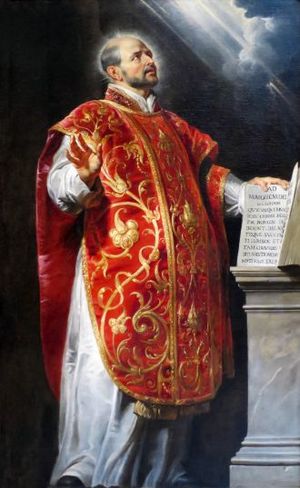 Finally at the end of his pilgrimage to Holy Places, a Franciscan responsible for guarding them, ordered Ignatius to depart from Palestine; he feared the Muslims persecution and thought he might be kidnapped. Therefore, he renounced his desire to stay in Holy Land and obeyed without knowing what to do upon his arrival to Europe. Again, Divine Providence had other designs for this generous soul. In 1524, he arrived in Spain, and dedicated himself to studying, thinking this would be a way to better help souls. A pious woman from Barcelona, named Isabel Roser, assisted him while he studied Latin grammar in school. At the time, Ignatius was 33 years old, and we can imagine the difficulty of studying grammar at this age. In the beginning Ignatius was absorbed so in God that he forgot everything else; therefore, an attempt to conjugate the Latin verb “amare“ ended up becoming a simple pretext to think, “I love God and God loves me.” Through all this the saint progressed in his studies, even though he continued to practice austerities and dedicated himself to contemplation. He also supported with patience and good humor the ridicules from his class mates who were much younger then himself.
Finally at the end of his pilgrimage to Holy Places, a Franciscan responsible for guarding them, ordered Ignatius to depart from Palestine; he feared the Muslims persecution and thought he might be kidnapped. Therefore, he renounced his desire to stay in Holy Land and obeyed without knowing what to do upon his arrival to Europe. Again, Divine Providence had other designs for this generous soul. In 1524, he arrived in Spain, and dedicated himself to studying, thinking this would be a way to better help souls. A pious woman from Barcelona, named Isabel Roser, assisted him while he studied Latin grammar in school. At the time, Ignatius was 33 years old, and we can imagine the difficulty of studying grammar at this age. In the beginning Ignatius was absorbed so in God that he forgot everything else; therefore, an attempt to conjugate the Latin verb “amare“ ended up becoming a simple pretext to think, “I love God and God loves me.” Through all this the saint progressed in his studies, even though he continued to practice austerities and dedicated himself to contemplation. He also supported with patience and good humor the ridicules from his class mates who were much younger then himself.
After two years of studying in Barcelona, he continued on to the University of Alcala to study logic, physics and theology; but so many classes only confused him, even though he studied day and night. He stayed in an orphanage, lived from donations and dressed in a grey habit. On top of his studies, he instructed children, organized spiritual meetings in the orphanage, and converted numerous sinners with his reprimands full of compassion.
Many difficulties existed for him in Spain at the time. Ignatius lacked the studies and authority to teach. He was accused before the bishop’s general vicar, who imprisoned him during 42 days, until finally absolving Ignatius and his companion of all accusations; however, he still prohibited them from wearing a particular habit and teaching for the next three years. Ignatius moved to Salamanca with his companions. Shortly after, he was accused again of introducing dangerous doctrines. After three weeks in prison, the inquisitors declared him innocent. Ignatius considered the prison, the sufferings, and the ignominy as trials that God sent to purify and sanctify him. When he was free again, he decided to leave Spain. In the middle of winter he made a trip to Paris, arriving in February of 1528.
Studies in Paris
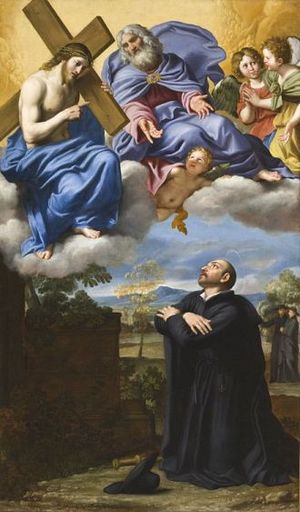 The first two years he dedicated to the perfection of Latin on his own. During the summer time he traveled to Flandres, and even to England, begging alms from the Spanish merchants established in the region. With the help from his friends in Barcelona he was able to study during the year. He stayed three and half years in the School of St. Barbara, dedicated to philosophy. He helped many of his companions to consecrate Sundays and feast days to prayer and more Christian fervor.
The first two years he dedicated to the perfection of Latin on his own. During the summer time he traveled to Flandres, and even to England, begging alms from the Spanish merchants established in the region. With the help from his friends in Barcelona he was able to study during the year. He stayed three and half years in the School of St. Barbara, dedicated to philosophy. He helped many of his companions to consecrate Sundays and feast days to prayer and more Christian fervor.
But professor Peña believed that the preaching of Ignatius impeded his companions from studying. He presented this complaint to Doctor Guvea, rector of the college, who then condemned Ignatius to flagellation and discredited him before his companions. Ignatius did not fear the sufferings or humiliations, but he did fear his punishment might turn away those who had started to walk in the Lord’s path. Therefore, he went to talk to the rector and explained with modesty the reasons for his conduct. Guvea did not respond, but took Ignatius by the hand, brought him to the classroom where all the students were gathered, and publicly asked forgiveness for hearing and believing so easily the false rumors.
In 1534, at 43 years old, Ignatius obtained a Masters of Arts degree from the University of Paris.
The Lord gives him his first companions
Ignatius’ fervent words, full of the Holy Spirit, opened the hearts of many of his companions. During this time six students of theology joined Ignatius: Pedro Fabro, priest from Saboya; Francisco Javier, from Navarra; Lainez and Salmeron, brilliant in their studies; Simon Rodriguez, originally from Portugal; and Nicolas Bobadilla. Moved by the exhortations of Ignatius, these fervent students made vows to be poor, to be chaste, and to go and preach the Gospel to Palestine; or if this was not possible, than offer themselves to the Pope, so he may decide were they should go to serve God best. The ceremony took place in the Chapel of Montmartre, where all received Holy Communion from the hands of Pedro Fabro, just newly ordained. It was the day of the Assumption of Mary, 1534. Ignatius maintained the fervor among his companions through frequent spiritual conversations and with a simple rule of life.
Shortly after, his theology studies were interrupted because the doctors ordered him to go and get fresh air due to the decline in his health. Ignatius parted for Paris in the spring of 1535. His family received him with great joy, but the saint refused to stay in the Castle of Loyola and stayed in a poor house in Azpeitia.
Papal blessing; apparition of the Lord
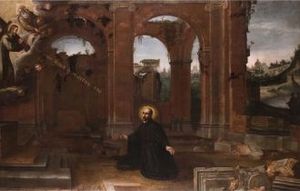 Two years later, he reunited with his companions in Venecia. But because of the war between the Venetians and the Turks, he was prevented from embarking to Palestine. Ignatius’ companions at this time were 10 and were transferred to Rome; Pope Paul III received them well and granted to those not yet priests the privilege to receive the Holy Orders from any bishop. After the ordination, they retired to a house close to Venecia with the purpose to prepare themselves for the apostolic ministry. The new priests celebrated their first Mass between the months of September and October, except Ignatius, who waited more than a year because he wanted to be better prepared.
Two years later, he reunited with his companions in Venecia. But because of the war between the Venetians and the Turks, he was prevented from embarking to Palestine. Ignatius’ companions at this time were 10 and were transferred to Rome; Pope Paul III received them well and granted to those not yet priests the privilege to receive the Holy Orders from any bishop. After the ordination, they retired to a house close to Venecia with the purpose to prepare themselves for the apostolic ministry. The new priests celebrated their first Mass between the months of September and October, except Ignatius, who waited more than a year because he wanted to be better prepared.
Since no possibility on go to Holy Land remained, it was finally decided that Ignatius, Fabro and Lainez would go to Rome and offer their services to the Pope. They also agreed that, if asked about the name of their association, they would respond that they belonged to the Company of Jesus (Ignatius never used the name “Jesuit”). This name started as a nickname because they were determined to fight against vice and error under the banner of Christ. During his trip to Rome, praying in the Chapel of “La Storta,” our Lord appeared to Ignatius surrounded by a halo and divine light, carrying a heavy cross. Christ said to him, “Ego vobis Romae propitius ero” (you will be favored in Rome). Pope Paul III named Father Fabro professor of the University of la Sapienza and entrusted to Lainez the mission of explaining Holy Scripture. Ignatius dedicated himself to the preaching of Exercises and to catechizing the people. The rest of his companions worked in similar missions, even though they were not fluent in Italian yet.
The Company of Jesus
Ignatius and his companions decided to form a religious congregation to extend their work. They were to embrace the vows of poverty, chastity, and obedience in imitation of the Son of God, who became obedient till death. A superior general needed to be named, one whom all would obey and one who would carry the obligation for the rest of his life with absolute authority subjected to the Holy See.
In addition to the vows mentioned above, another vow was added: to go and work for the good of souls where ever the Pope sends them. The obligation to sing together the divine office would not be required in the new order, “so we will not be distracted from the charitable works to which we have consecrated ourselves.” By no means was prayer neglected, for each member was to pray at least one hour daily. The first work of charity consisted of “teaching children and all men the commandments of God.“ The Pope named a commission of cardinals to study the order. With the idea that the Church had already enough religious orders, the cardinals showed adversity. One year later their opinions changed, and Pope Paul III approved the “Company of Jesus” by a Papal Bull on September 27th, 1540.
Ignatius was elected first superior general of the new order and his confessor, through a call to obedience, asked him to accept the mission. He started to exercise this role on Easter Sunday of 1541, and a few days later all the members made their vows in the Basilica of Saint Paul Outside the Walls.
Ignatius spent the rest of his life in Rome, consecrated to the work of governing the order he founded. Among other things, he founded a house to help accommodate neophyte Jews during their catechetical period and other houses for repented women. On one occasion someone said to him that true conversion for such sinners is rare and not sincere. Ignatius responded, “I’m willing to suffer anything for the joy of knowing that one sin is prevented.“ Rodriguez and Francis Xavier departed to Portugal in 1540. With the help of King John III, Xavier was transferred to India, winning a new world for Christ. The priests Gonclaves and Juan Nunez Barreto were sent to Morocco to instruct and help the Christian slaves. Four other missionaries were sent to Congo, some others to Ethiopia and the Portuguese colonies of South America.
A defense of the truth and order before Protestantism
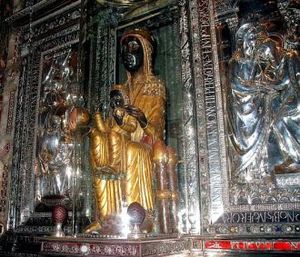
At the Council of Trent, Pope Paul III named Father Lainez and Father Salmeronas his personal theologians. Before leaving to their new assignment, St. Ignatius ordered them to visit the sick and the poor; in disputes always show modesty and humility; abstain from being pretentious or showing pride in their sciences; and not argue much. However, without doubt the most famous of St. Ignatius’ first disciples in Europe was Saint Peter Canisio, known for his virtue and wisdom. His is venerated in the Church today as a Doctor. In 1550, Saint Francis Borja gave a large sum of money for the edification of the Roman School. Saint Ignatius made of it a model school for the rest in the order. He worked to establish there the best teachers and to facilitate the best possible progress in the sciences.
The saint also directed his work to the foundation of the Preparatory School of Rome, which trained and formed the priests for missionary work in countries invaded by Protestantism. During the saint’s lifetime many universities, seminaries and schools were founded in different countries. Saint Ignatius placed the foundation for educational work that distinguishes the Company of Jesus and that has developed so well through the years.
In 1542, the first two Jesuit missionaries landed in Ireland, but the attempt failed. St. Ignatius asked for prayers for the conversion of England. Among the martyrs of Great Britain, twenty-nine are Jesuits. The presence, activity and good example of the Company of Jesus in England proved the importance of their role during the contra-reformation of the time. This movement had a double purpose: to give new vigor to the life of the Church and to oppose Protestantism.
Revolution and disorder were characteristics of the reformation. The characteristics of the Company of Jesus were obedience and solid consistency. We can therefore affirm as historic truth that the Jesuits attacked, rejected and defeated the Lutheran revolution. With their preaching and spiritual direction, they re-conquered many souls for Christ crucified. The message of the Company of Jesus deserved and obtained the confidence and obedience of souls. We cite the following message about relations with Protestants, given by St. Ignatius to the priests of the Company of Jesus who were leaving to found a school in Ingolstadt, Germany: “Be careful in preaching the truth in such a way that, if among the crowd there is a heretic, thy preaching to them bean example of charity and Christian moderation. Do not use harsh words, nor show contempt for their errors.” The saint also wrote the same to Father Broet and Salmeron when they departed for Ireland.
The Spiritual Exercises
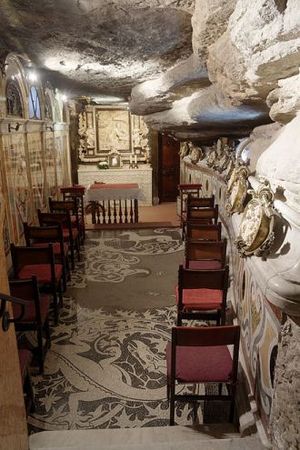
One of the most famous and fruitful works of St. Ignatius was the book of Spiritual Exercises. It is the master work in the science of discernment. He started to write it in Manresa and published it for the first time in Rome, in 1548, with the Pope’s approval. The Spiritual Exercises are perfectly aligned with the Church tradition – since the beginning of the Church, some Christians would go away from the world to serve God better; as well, the practice of meditation is also from the beginning of the Church. What we find new in the book of the Spiritual Exercises is the order and systematic way of meditations. St. Ignatius methodically, and with perfect clarity, ordered and formulated the counsels and rules that the Fathers of the Church had disseminated in many different works.
St. Ignatius’ prudence and charity during his government won the hearts of his subjects. He was affectionate with them as a father, especially towards the sick, whom he personally assisted by trying to give them the best possible material and spiritual assistance. Even though St. Ignatius was the superior, he knew how to hear his brothers with meekness, but without ever diminishing his authority. In cases not so clear, he would humbly submit himself to the counsel of others. He was strongly opposed to using superlative (exaggerated) expressions and too many categorical affirmations during a conversation. He knew how to handle criticism with joy, and he also knew how to reprimand his subjects when he saw the need. Particularly he reprimanded those who became proud because of their studies or knowledge and lukewarm in the service of God. On the other hand, he encouraged the studies, desiring that professors, preachers and missionaries be men of knowledge.
St. Ignatius’ crown of virtue was his great love of God. Frequently he repeated these words that are the motto of his order: “All for the greater glory of God.“ To this end the Saint referred all his actions and all his activities of the Company of Jesus. He also said frequently, “Lord, what can I desire apart from you?” He who truly loves never is inactive. St. Ignatius placed his happiness in working for God and in suffering for Him and His cause. Perhaps the “military spirit” of St. Ignatius and the Company of Jesus has often been exaggerated, and forgotten has been their compassion and gift of friendship.
During Ignatius’ 15 years in the government of the order, it grew from 10 to 1000 members, extended to nine European countries, India and Brazil. During those 15 years the Saint became ill 15 times; therefore, no one became alarmed when he became ill one more time. He died suddenly on July 31, 1556, without having time to receive the last sacraments. He was canonized in 1622, and Pope Pius XI proclaimed him Patron of the Spiritual Exercises and retreats.
The fountain of enthusiasm for Ignatius’ zeal for the salvation of souls was ‘the love of God,’ the reason for which he worked so hard in different missions, consecrated his life, spent much time in prayers and vigils, shed many tears, and dedicated himself to hard work. He did everything possible to win souls, embracing with love all sinners sincerely repented. Frequently he would impose on himself part of their penance and exhorted them to offer themselves in perfect holocaust to God. He would tell them that it was impossible to imagine the treasures of graces God had reserved for those who give themselves completely from the heart.
“Take, Lord and receive all my liberty, my memory, my understanding, and my entire will. You have given them to me; to you Lord, I return it. Dispose of me according to Your will, and only give me your love and your grace; that’s enough for me; I ask nothing more.“
Pope John Paul II said, “St. Ignatius knew how to obey when, in midst of healing his wounds, the voice of God was heard with force in his heart. He was sensitive to the inspiration of the Holy Spirit.“
St. Ignatius is the great teacher in discernment of spirits
Discernment of spirits is the capacity to distinguish between the voice of the Holy Spirit and bad spirits. Events early on in Ignatius’ conversion helped him greatly in understanding and with discernments.
As a young man Ignatius was very fond of chivalry books and narrations full of imaginary stories. When he felt recuperated from his injury, he asked for some of these books to read and to pass the time, but in that house there were none. Instead he was given the book Life of Christ and another called Flos santorum, written in Spanish. He began to be interested in the things he was reading about in these books. He would think on and off about what he read; but old habits continued to lead him to think much on his past, and he entertained his imagination with vanities and habits that were part of his past life.
God’s divine mercy, however, was acting during this time, gradually inspiring his will with other thoughts. Upon reading the life of Jesus Christ or the saints, he would stop and think to himself, “what if I were to do the same as St. Francis or St. Dominic?” In this way his mind was always active. These thoughts would last a long time until, distracted again, he would return to the vain thoughts of the world. This succession of thoughts lasting a long time. But there was a difference – when he thought about the things of the world, it would produce great pleasure at the moment; but once bored and tired of it, he would return to reality and feel sadness and aridity of spirit. On the contrary, when he thought of the possibility of imitating the austerities of the saints, he experienced lasting and intense happiness and joy.
He did not notice these differences until, one day, the eyes of his soul were opened and he began to admire the difference he was personally experiencing. While some thoughts left him sad, others, on the contrary, left him happy. This is how he started to seriously reflect on the things of God. Later on in his life, when he dedicated himself to the spiritual practices, this experience helped him comprehend and understand the discretion/discernment of spirits he would later teach others.
The Spiritual Exercises
The purpose of the Spiritual Exercises is to take souls to a serious state of detachment from the world so they can choose, “without being driven by pleasure or repulsion, towards a general course of life at a particular point or time of life. The principle motive to guide this election in your life is what leads to the Glory of God and the perfection of the soul.”
Pope Pius XI said, “The Ignatian method of prayer guides the soul through the way of self abnegation and of self control or dominion of bad habits to the highest degree of contemplation and divine love.” The Spiritual Exercises have been and continue to be the instrument that God uses to communicate His Spirit to an innumerable number of souls towards holiness.
They begin by reflecting on the “Principle and Foundation“ of all things. They show us the fundamental truths in which we should edify our lives: What is the origin of existence? What is life’s purpose? What is its value? These are the main question one should ask himself. The answer is given by God in Genesis 1:26 when God said, “Let us make man in our image, after our likeness.” God is love (1 John 4:16), and man is made in God’s image; therefore, he has been created to love with his heart, like the heart of God. God created man to love with all his heart, all his mind and strength (Deut. 6:4-9).
Man loves God before anything when he adores, praises and serves Him. In this line one’s existence should be ordered. By its very nature love seeks union. God created us to be His adoptive children in Jesus Christ and for Jesus Christ. God’s plan consists in making us participants, on earth (through faith and grace) and for eternity, in the life of the Trinity Who is Love.
The principal and foundation of our lives is this: We have been created to praise, adore and to serve God, and through this, save our soul. Being aware of this principal and foundation, and ordering all our lives in Him, we can construct upon solid rock, so in times of torment our house will not crumble. Inigo Lopez de Loyola y Onaz was born in 1491, the thirteenth child in a family of minor nobility. At the age of sixteen Inigo left his home to serve as a page to the treasurer of the kingdom of Castille. As a page he was exposed to a life of riding, dueling, gambling, dancing and romancing young ladies.
When he was twenty-six, Inigo took up the life of a solider in the northern town of Pamplona. He was injured during battle when a cannonball crashed through the fortress he was defending and shattered his leg. Inigo was taken back to his brother’s castle in Loyola, where doctors reset his leg.
During his six month recovery, Inigo passed his time reading two books, one about the life of Christ and the other about tales of the saints. As he read and pondered these books, he noticed a change taking place within him. Daydreams of serving the king as a valiant knight and winning the love a noble lady, though at first enticing, ultimately left him feeling inwardly dry and discontented. By contrast, when he imagined devoting his life to the service of God and others, similar to the saints he was reading about, Inigo experience a deep sense of joy. Ignatius become convinced that God was speaking to him through these interior attractions and reactions.
After he recovered, Inigo left behind his brother’s home and traveled widely — begging, preaching and caring for the sick and poor. One of his first stops was at a Benedictine mountain-top shrine of Our Lady at Montserrat. There, after an all-night vigil, the young romantic left behind his sword before the altar of Our Lady and donned the sackcloth of a beggar.
From Montserrat he set out for the small town of Manresa. Inigo stayed there for ten months, spending hours every day in solitary prayer and working at a hospice. He discerned carefully the interior movements of his soul: distinguishing the attractions, feelings, thoughts, and desire that led him to great intimacy with Jesus Christ from those that were distractions to his spiritual growth. Trying to outdo the piety of the saints he read about, Inigo took on severe bodily penances. At times, he became mired in self-doubt. Through prayer and wise spiritual guidance, he discerned that his seemingly pious acts of penance were really displays of vanity.
Inigo began to make notes of his spiritual insights. He talked to people about the spiritual life whenever and wherever he could, recording the fruit of these conversations. These notes became the basis for a manual of prayer that he would later title the Spiritual Exercises.
Inigo ultimately desired to end up in Jerusalem to spend the rest of his life in the place where Jesus lived and labored. However, because of the dangerous political situation in the Holy Land, he had to leave only a few weeks after he arrived in 1523. Inigo was learning that he had to be flexible in responding to God’s will in his life. His decisions simply needed to be directed toward “helping souls,” which could be done in many ways.
Once back in Spain, Inigo decided to begin studies for the priesthood, but he lacked knowledge of Latin, the language of the Church. So at the age of thirty-three, he spent two years in Barcelona, studying alongside school-children. Inigo subsequently attended universities in Alcala and Salamanca. Inigo then traveled to the renowned University of Paris to study philosophy and theology. There he became known as “Ignatius,” a Latin form of his name. In Paris, he met other students like him — Francis Xavier and Peter Faber — who were captivated by Ignatius’ experience of God, his vision of the world, and his adventurous spirit.
On August 15, 1534, in a small chapel on Montmartre, Ignatius and six other men professed religious vows of poverty and chastity to bind them more closely together. After their studies, the companions, now eleven in number, met in Venice and preached, worked in hospitals, and gave the Exercises. Ignatius and those others who were not yet priest were ordained in 1537.
The companions, “friends of Jesus”, traveled to Rome and deliberated for many weeks about their future, all the while teaching, preaching, and performing works of mercy. They eventually decided to form a religious order under a vow of obedience to a superior, Ignatius. The companions, soon to be called Jesuits, shorthand for Society of Jesus, vowed to go wherever the Church’s needs were the greatest and wherever they could help the most souls. Unlike monastic religious orders, their home would be the road, constantly meeting people along the way. They offered the Church a spirituality that was both mystical and practical; the first generation of Jesuits decided to be “contemplatives in action.”
When their religious order was formally constituted in 1540, the Pope began to depend on the Jesuits for important missions throughout the world. The Jesuits opened schools all over Europe and across the seas to meet the dire need for an educated clergy and faithful. Ignatius and his Jesuits chose as their motto “Ad Majorem Dei Gloriam,” a Latin phrase that means “for the greater glory of God.” This would be the standard for all of their missions.
Ignatius died on July 31, 1556, suffering the effects of a persistent stomach ailment. At his death, the Society numbered nearly 1,000 men, with houses and colleges stretching from Brazil, across Europe, and to Japan. Ignatius was canonized, together with Francis Xavier, in 1622.
Many recognize St. Ignatius for his incredible contribution to discernment of God’s will and spiritual retreats, however, many do not know that he had a quite spectacular encounter with Our Lady that allowed him to become the saint that we know him to be.
We must understand that he had already had his initial conversion after his injury from battle and he had already begun to experience and formulate what would later become the Spiritual Exercises. Prior to this apparition, he had entered a period of reparation for his past sins, which included fasting and scourging himself. These would have been considered quite normal for any ascetic at the time. What we can understand from this experience of St. Ignatius is the importance of Chastity and Our Lady’s role in bringing us to that point. The Scriptures are quite clear when the Psalms say “Who can climb the mountain of the Lord? The man with clean hands and a pure heart…” (Psalm 24)
Notice that this was not given to him simply as the result of his effort; his effort merely laid the groundwork for this incredible and free gift that was given to him by God through Our Lady. Just as Our Lady’s Immaculate Conception was the foundation for her mission in her life, so too was this gift of chastity essential for St. Ignatius establishing the Jesuits as well as giving us the Spiritual Exercises. Is this any surprise, since our God is a God of Love and love is above all things pure and chaste.
In every major religion of the world, we see a great desire to commune with the Divine and to climb that difficult mountain. The gift of Chastity is the most difficult obstacle for every human to overcome since it is ultimately the work of God to overcome our lusts and sinful desires. The only thing that we can do is prepare the groundwork to receive this gift from the hands of Our Lady.
Let us imitate the example of St. Ignatius, atone for our sins and lay the groundwork for God to give us this magnificent gift of chastity through the most pure and holy hands of Our Blessed Mother.
Read and meditate on what is written in his Autobiography:
“The vain thoughts were gradually lessened by means of these desires — desires that were not a little strengthened by the following vision. While watching one night he plainly saw the image of the Blessed Mother of God with the Infant Jesus, at the sight of which, for a considerable time, he received abundant consolation, and felt such contrition for his past life that he thought of nothing else. From that time until August, 1555, when this was written, he never felt the least motion of concupiscence. This privilege we may suppose from this fact to have been a divine gift, although we dare not state it, nor say anything except confirm what has been already said. His brother and all in the house recognized from what appeared externally how great a change had taken place in his soul.”


